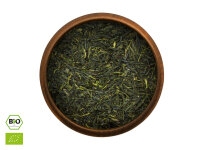"Japanese teapot Tokoname Tobikanna Kuro"
Gyokko - the Master of Pottery
When it comes to the petite teapots known as Kyusu, Master Gyokko stands among the elite. He has been recognized with numerous awards for his delicate craftsmanship, including the Japan Sencha Art, Choza-Sho Pottery Exhibition, Encourage Prize, and the "Excellent Craftsmen" Award. His creations are a testament to beauty, precision, and intricate detail. Every Kyusu crafted by Gyokko is hand-formed on the potter's wheel. Notably, his expertise in "baking" or firing pottery sets him apart. He is a maestro in the technique of "reduction firing," which yields his signature iridescent shades. Some of his works dazzle with vivid color plays and gradients, while others showcase a color consistency exemplary of one-of-a-kind pieces. The essential ingredient for this art is shudei, a purely natural red clay with a high iron content. But Gyokko's mastery isn't just aesthetic; he infuses practicality by integrating a ceramic sieve with over 400 hand-poked holes into his teapots. This feature is often favored by tea connoisseurs over stainless steel sieves.
Clay Teapots: Characteristics, Origin, and Firing Method Are Closely Interlinked
The four primary regions for Japanese clay teapot craftsmanship are Mie Prefecture (Banko Yaki), Gifu (Onko Yaki), Aichi Prefecture (Tokoname Yaki), and Sado Island in Niigata Prefecture (Mumyoi Yaki). All these areas boast clay deposits rich in minerals. Ogaki initiated the production of Japanese clay teapots (Onko Yaki) in the 19th century, though this tradition has since ceased. What endures is his introduced technique of crafting Japanese teapots from clay on the potter's wheel. Even today, in renowned hubs like Tokoname and Yokkaichi in Mie Prefecture, these teapots are shaped by master potters on the wheel. The primary firing techniques include reduction firing and oxidation firing. Teapots from reduction firing usually offer a muted to neutral character, suitable for all green teas. In contrast, oxidation-fired teapots enhance the diverse flavors of green tea.
Tokoname Yaki: Japanese Teapots from Tokoname
Tokoname, celebrated as one of the ancient kilns for clay production, enjoys renown beyond Japan's borders. Among its wide variety of clay products, Japanese teapots hold a special place. Tokoname is home to a natural red clay known as Shudei. The color variations in teapots arise from the firing techniques—reduction or oxidation—and the controlled oxygen levels during the process. Crafting with this clay requires immense skill and experience, given its sensitivity. Tokoname's pottery history traces back to the 12th century, making it one of Japan's oldest kiln traditions. Initially, white clay from rice fields was the primary material. But a landmark discovery around 1954 by Sugie Jyumon and Dr. Hirano Chuji revealed Tokoname's natural red clay's superior mineral composition, leading to its prominence. A distinct decoration style for Tokoname teapots is the Mogake technique, pioneered by Ina Chozo. This method involves wrapping the teapots with seaweed pre-firing. The ensuing chemical reactions between the seaweed and clay minerals result in unique surface patterns.
The Advantage of Natural Clay
The distinction between natural and mixed clay lies in the iron's state. In natural clay, iron exists in a crystallized form. In contrast, mixed clays use pre-ground iron, which leads to a varied, broader surface texture and a lower melting point compared to natural iron. Consequently, tableware crafted from clay or loam with added iron is fired at temperatures between 600-800 degrees. Meanwhile, Japanese teapots made from natural clay can endure firing up to 1200 degrees. This higher temperature not only boosts the product's durability but also influences its material transformation. Today, many clay teapots, particularly those mass-produced in China and Japan, derive from artificially mixed clay.
Cleaning: Rinse both the exterior and interior with warm water only. Avoid cleaning agents. If contamination occurs, infused green tea can be used for removal. Regular use imparts a tea patina to the teapot, adding to its character and need not be removed.























